Great White Shark
Carcharodon carcharias
Have up to 300 serrated, triangular teeth!
Advertisement
Great White Shark Scientific Classification
- Kingdom
- Animalia
- Phylum
- Chordata
- Class
- Chondrichthyes
- Order
- Lamniformes
- Family
- Lamnidae
- Genus
- Carcharodon
- Scientific Name
- Carcharodon carcharias
Read our Complete Guide to Classification of Animals.
Great White Shark Conservation Status
Great White Shark Facts
- Prey
- Seals, Sea Lions, Dolphins
- Name Of Young
- Pup
- Group Behavior
- Solitary
- Fun Fact
- Have up to 300 serrated, triangular teeth!
- Estimated Population Size
- Unknown
- Biggest Threat
- Hunting and habitat degredation
- Distinctive Feature
- Large pointed snout and powerful tail fin
- Other Name(s)
- White Shark, White Pointer Shark
- Optimum pH Level
- 5 - 7
- Incubation Period
- 12 - 18 months
- Age Of Independence
- From birth
- Average Spawn Size
- 9
- Habitat
- Temperate, coastal waters and open ocean
- Diet
- Carnivore
- Lifestyle
- Diurnal
- Common Name
- Great White Shark
- Number Of Species
- 1
- Location
- Worldwide
- Slogan
- Can grow to more than 8 meters long!
- Group
- Fish
View all of the Great White Shark images!
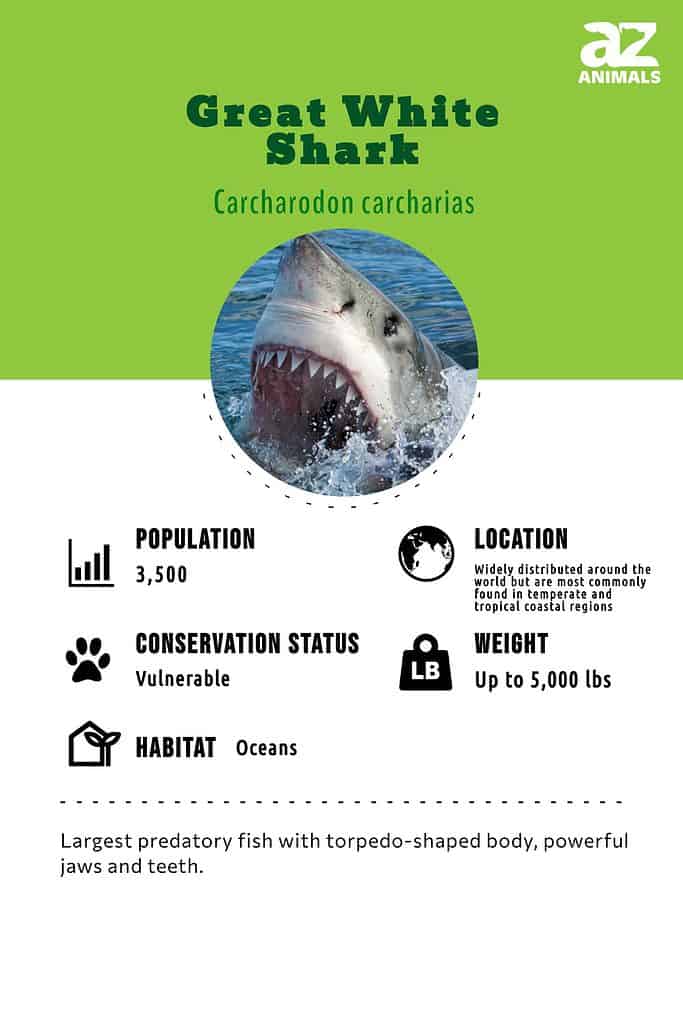
Classification
The great white shark, Carcharodon carcharias, is a large shark found mainly inhabiting temperate and tropical coastal waters worldwide. They are the largest predatory fish species in the world, known to grow to lengths of 8 meters or more and weighing over 2 tons (4,000 pounds). Great white sharks are huge, powerful predators that have developed a fearsome reputation as one of the most prolific “man-eaters” on the planet, with up to half of the annual shark attacks on humans reportedly caused by them. Also known as white sharks and white pointer sharks, great white sharks have been one of the most ruthless ocean predatory fishes for nearly 20 million years. Still, despite their high-profile reputation, they are much less common compared to other widely distributed shark species. Although surprisingly little is still known about their biology and population sizes, it is widely agreed within the scientific community that great white shark population numbers are decreasing worldwide as they are threatened by both hunting and habitat loss throughout much of their natural range.
Evolution
Sharks have lived on the earth longer than almost any other animal – 450 million years – surviving mass extinctions and every other environmental hazard. 3,000 species have lived over a period of nearly half a billion years – making them an evolutionary success story.
Silurian Period: 450 Million Years Ago
Sharks began developing as a unique species while the world’s oceans were filled with a variety of fish. The Acanthodian was the very first ancestor of the modern shark. This fish looked like a shark and was the first fish to develop the cartilaginous skeletal structure that sharks have today.
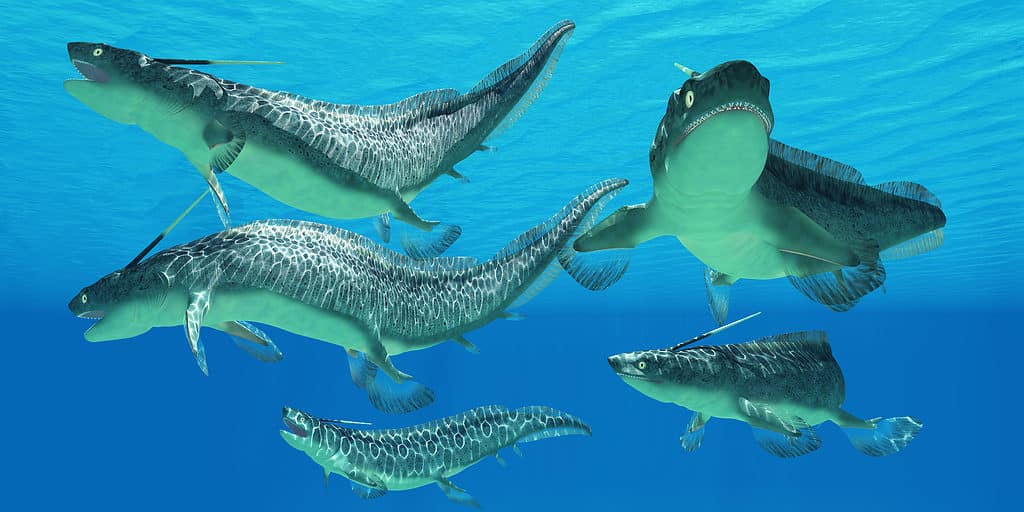
Very few complete fossils have been found of
Xenacanhusand most information about the animal has been found through teeth and spine samples.
©iStock.com/CoreyFord
Early Devonian Era
The very first, fully developed shark came on the scene 50 million years after the Silurian era. The Leonodus Shark and the Anrarctilamma were two eel-like early sharks in the now-extinct genus Xenacanhus.
Late Devonian Era
The first modern-looking shark, the Cladoselache, broke off from its eel-like cousins. With a six feet long, streamlined body, gill slits, and dorsal fins, this shark lacked the pointed nose and flexible jaw of the modern shark.
The Carboniferous Era
Around 360 million years ago, sharks ruled the oceans and split into many subspecies including rays, skates, and chimaeras. There were 45 different families of sharks during this time, including: Sthacanthus and the unicorn shark, Falcatus.
Jurassic Era
12 new families of sharks appeared around 200 million years ago during the Jurassic period. Sharks began developing protruding, flexible jaws to enable them to attack larger prey – and tail fins for faster swimming. Their mouths began to form under their snouts and they were able to go deeper to reach more prey. The Hybodus or horned shark lived during this time.
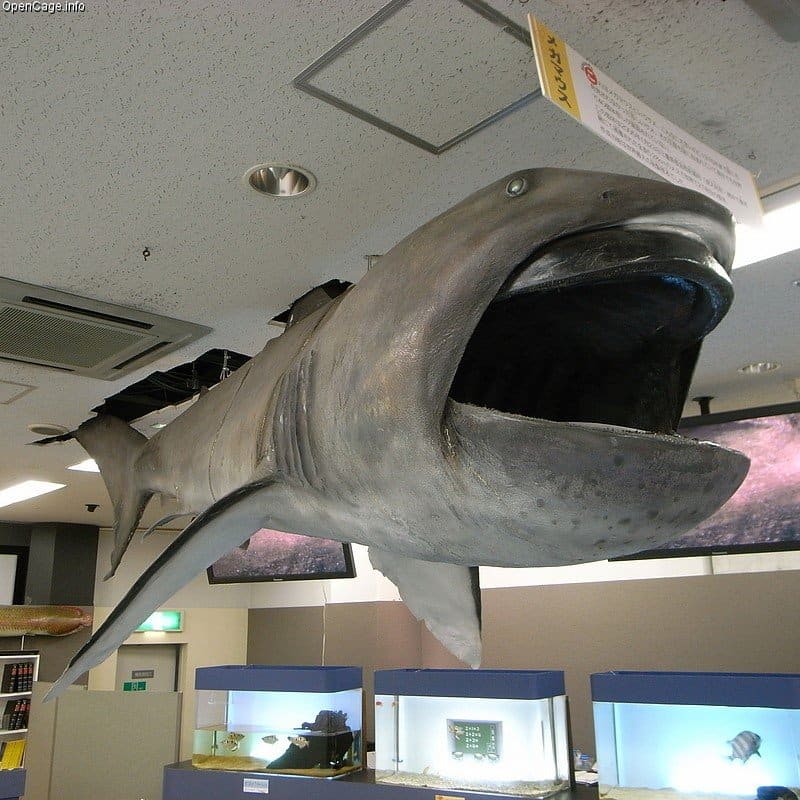
Megamouth shark,
Megachasma pelagios,at Toba Aquarium, Japan
Cretaceous Period
During this era, 145 – 65 million years ago, sharks evolved that are still in existence today. The Goblin shark, Frilled shark, Whale shark, Basking shark, and Megamouth shark hunted the seas. Lamnidae Sharks or white sharks evolved – the ancestors of great whites, mako, and bull sharks.
Early Cenozoic Era
60 million years ago, during the early Cenozoic period, the Megalodon was the king of sharks. It was the biggest ocean predator ever to exist, 65 feet long and weighing over 30 tons. Megalodon was so fierce and huge with its 7-inch long teeth, that it preyed on whales. Its cousin, the Otodus, at 39 feet, was also a major predator of that era.
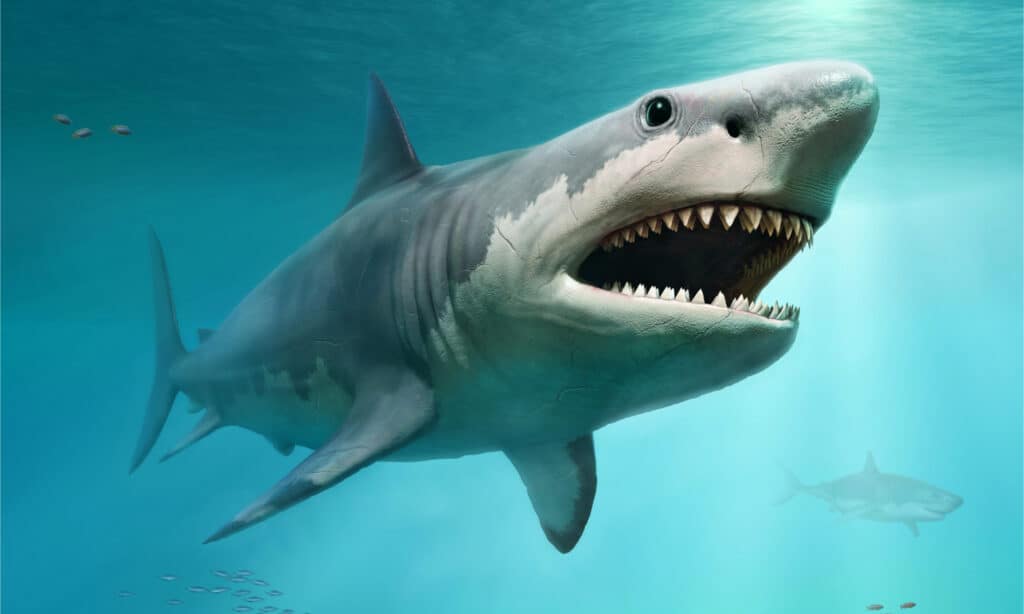
Megaladon weighed as much as 30 large great whites, reached up to 60 feet in length, and ate 2,500 pounds of food each day!
©Warpaint/Shutterstock.com
Scientists have believed that the great white evolved from Megalodon, Otodus megalodon, one of the largest sharks to have ever lived. Megalodon vanished from the fossil record around 3.6 million years ago. Why? Some scientists have started to theorize, after analyzing numerous fossils, that the great white actually may have helped to drive Megalodon to extinction. Great whites evolved about 4 million years ago, meaning that they lived among Megalodons for approximately 400,000 years. They weren’t as big – but maybe they were better hunters.
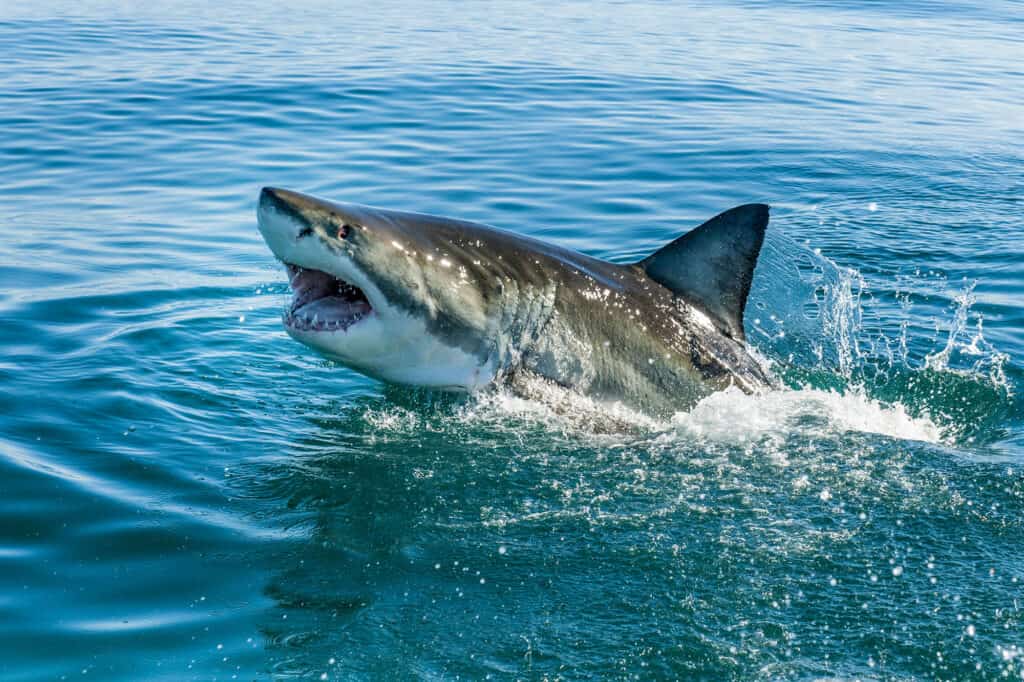
The Great White Shark is perhaps the deadliest predator in the world.
©iStock.com/ELizabethHoffmann
Anatomy and Appearance
Like almost all shark species, great white sharks have a highly distinctive appearance with large, torpedo-shaped bodies and a pointed snout. They have very tough skin that is covered in tiny teeth called denticles that is slate-grey to black on the top of their bodies which helps them to remain camouflaged on the rocky, coastal sea floors where they are most commonly found. The underside of the great white shark is white and is what has led to its name. Great white sharks have powerful, crescent-shaped tail fins that help to propel them through the water at a tremendous speed and are aided by their pectoral (side) fins that are held out in fixed wings to prevent the great white shark from sinking. The large and highly characteristic dorsal (back) fin of the great white shark is used to help them steer through the water, diving, as well as helping them to balance. One of the most characteristic features of the great white shark is its jaw. Its mouth is filled with up to 300 serrated, triangular teeth arranged in rows and replaced continuously throughout its life. Each tooth can grow to around 6cm in length, giving great white sharks a formidable bite when attacking their prey.
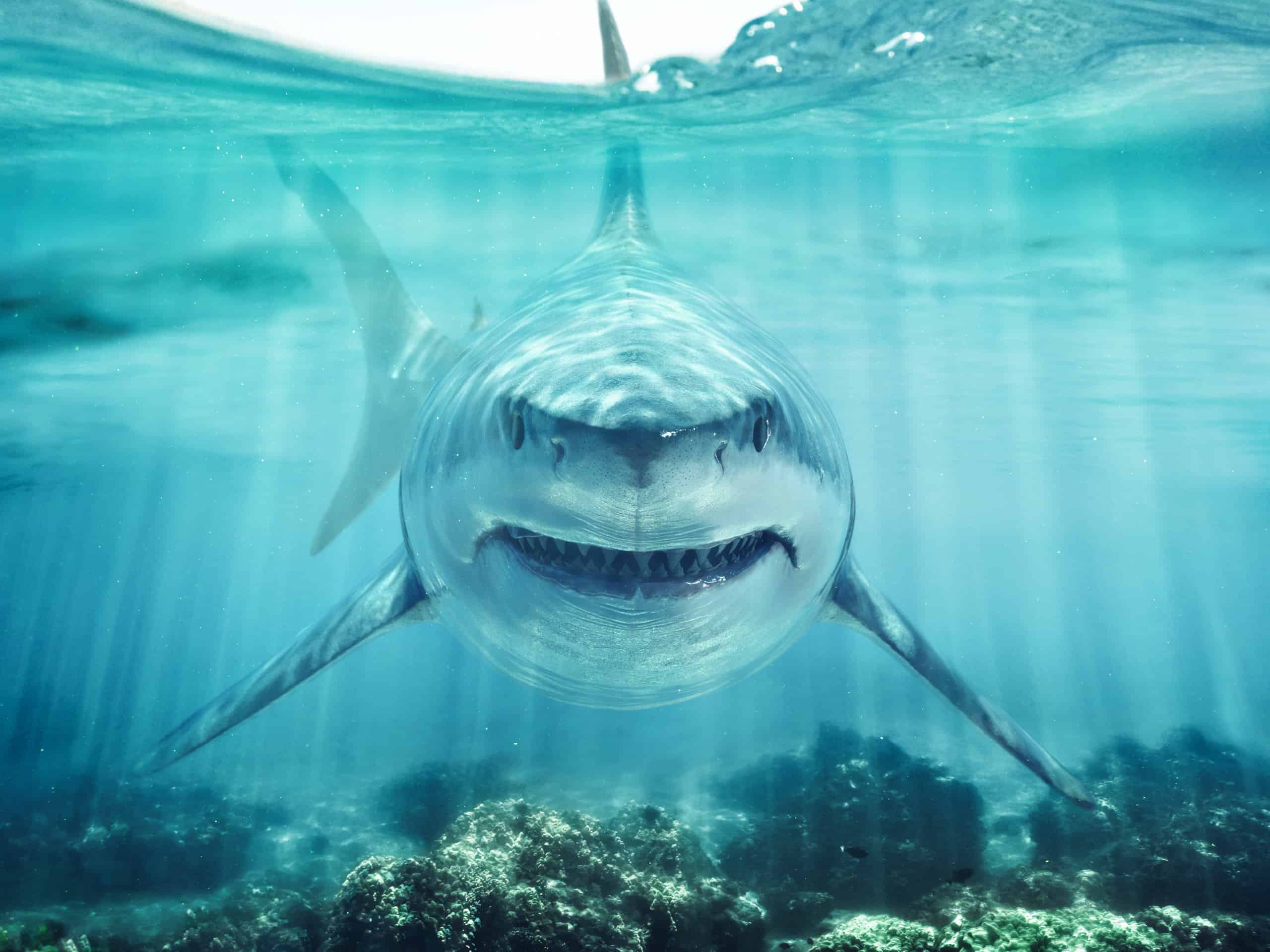
Face-to-face with a great white shark!
©Digital Storm/Shutterstock.com
Distribution and Habitat
Great white sharks are widely distributed around the world but are most commonly found in temperate and tropical coastal regions, cooler waters, and the open ocean. Despite this, they are most commonly seen in South Africa (where there are the biggest population numbers), Australia, California, and the northeast of the United States but are also known to range into cooler regions and visit tropical islands, including Hawaii and Seychelles in areas within a greater expanse of open water. Great white sharks swim either below the surface or off the ocean floor, depending on the region and their feeding habits. Their coastal dwelling nature is largely attributed to their prey species. Still, they are also known to travel vast distances through the ocean from South Africa to Australia and from the Californian coast to Hawaii in the deep Pacific.
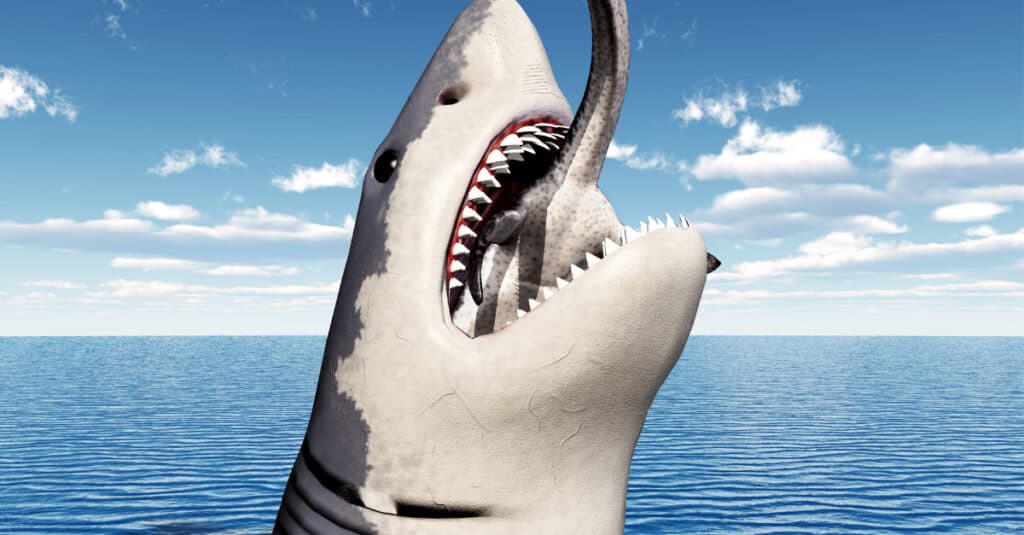
Great white sharks have even been commonly seen leaping out (breaching) of the water, similar to whales when they are attacking their prey from underneath.
©iStock.com/MR1805
Behavior and Lifestyle
Great White Sharks are largely solitary animals that only tend to come together to mate but have been seen in pairs or small groups around large carcasses. They are highly adaptable and powerful predators that rely less on their eyesight and more on other senses to detect their prey. When in the open oceans, Great White Sharks must swim constantly, or they will drown. Seawater is forced into their mouths and over their gills during swimming, where oxygen is taken in. Great White Sharks swim in an “s” shape to move through the water more efficiently. They can travel vast distances by flexing their body and moving their incredibly strong tail fins from side to side. Powerful and sudden movements of their tail fins enable Great White Sharks to make high-speed dashes when chasing fast-moving prey. They have even been commonly seen leaping out (breaching) of the water, similar to whales when they are attacking their prey from underneath.
You can check out some incredible facts about great white sharks.
Reproduction and Life Cycles
Like many other shark species, female Great White Sharks give birth to live young rather than laying eggs. The female Great White Sharks (bigger than the males) are thought to reach their reproductive stage at around age 17. After an estimated incubation period of between 12 and 18 months, the female gives birth to between 4 and 14 pups, roughly 1.2 meters long (or more). Great White Shark young hatch inside the uterus and are thought to gain nourishment from eating unfertilized eggs and other embryos until they have developed enough to be born. Female Great White Sharks are thought to have a new litter every 2 or 3 years, normally in warm coastal regions where the young have safe nursery grounds to grow. However, habitat degradation and human interference threaten many of these areas to keep Great White Sharks away from regions where people commonly surf and swim.
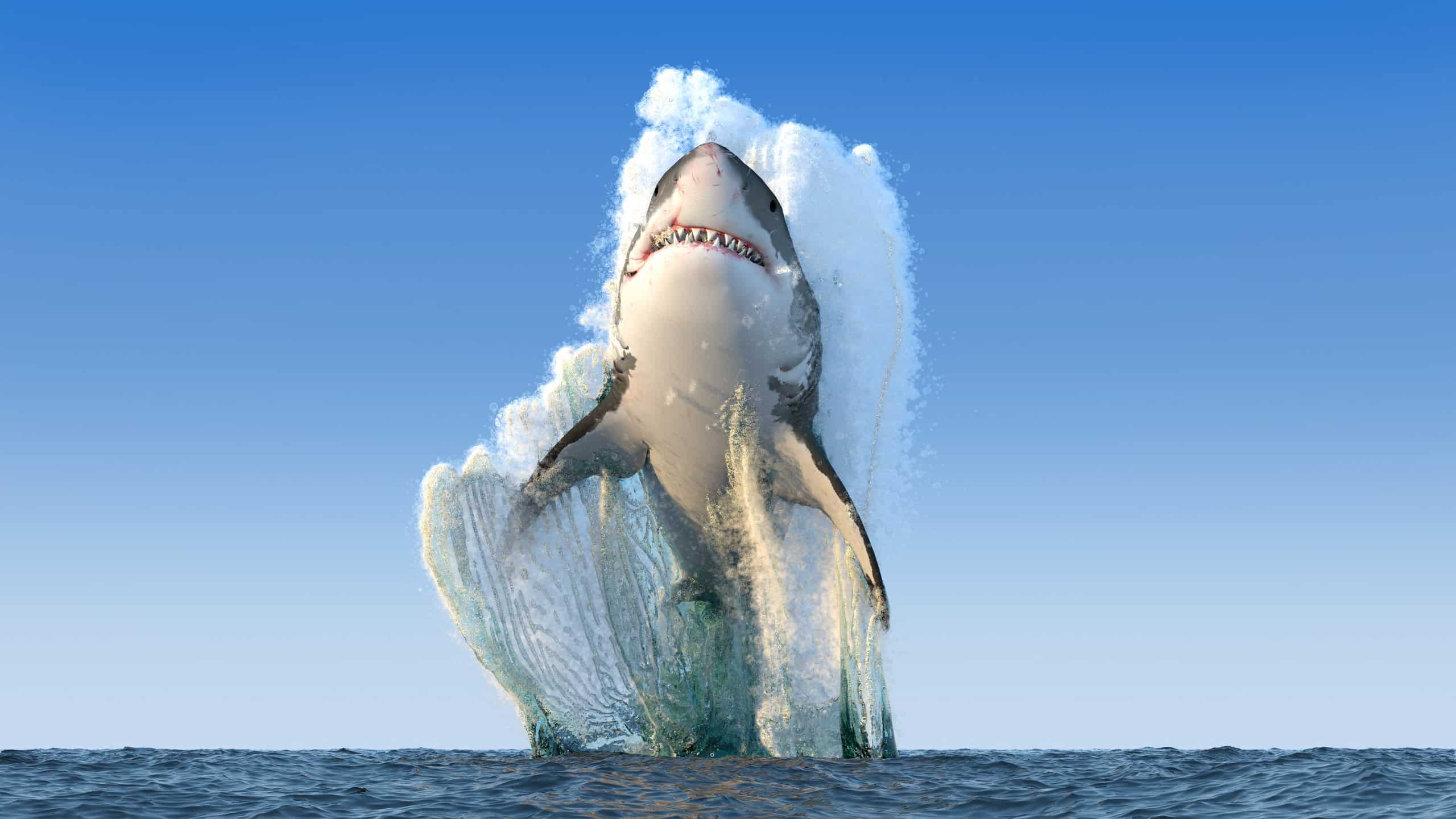
A massive great white shark leaping into the air in a grand display.
©Alexyz3d/Shutterstock.com
Diet and Prey
Great White Sharks are fearsome carnivores that primarily hunt large marine mammals for nutrition. Seals, sea lions, porpoises, dolphins, and smaller whales are among their most commonly hunted prey species worldwide. Great White Sharks have poor eyesight compared to their other senses and use their sense of smell and ability to detect vibrations caused by animals in the water to detect their prey. Once located, Great White Sharks fiercely attack with great speed and force before retreating and leaving their wounded prey to weaken before returning to feed once it is safe to do so. Although largely solitary, Great White Sharks can be seen in pairs or small groups to feed on a large whale carcass. In these circumstances, larger and more dominant individuals feed first with varying swimming display patterns thought to contribute to establishing their dominance hierarchy.
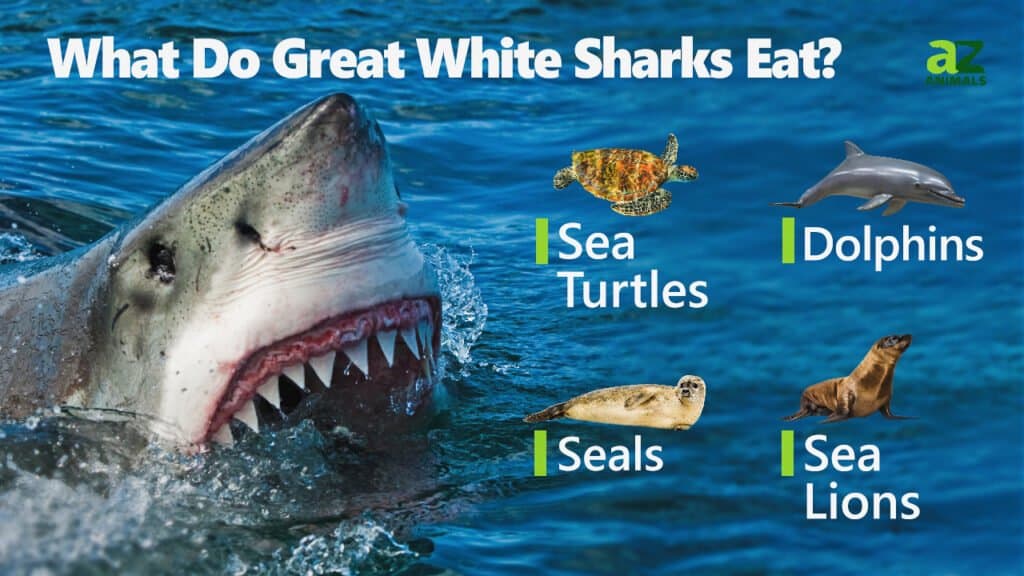
Predators and Threats
The Great White Shark is the largest predatory fish in the ocean and one of the most formidable aquatic hunters in the world, so naturally, very few animals would prey upon fully grown Great White Sharks. However, the smaller and more vulnerable juveniles are threatened by large ocean predators, including Killer Whales and other shark species. The biggest threats to the global population of Great White Sharks are those caused by people. Great Whites are hunted for their jaws, teeth, and fins by fishermen and trophy hunters and are also sometimes accidentally caught in nets fishing for other species such as Tuna. Beaches meshed to protect swimmers from shark attacks and habitat degradation throughout their natural range have also contributed to the global decline in population numbers.
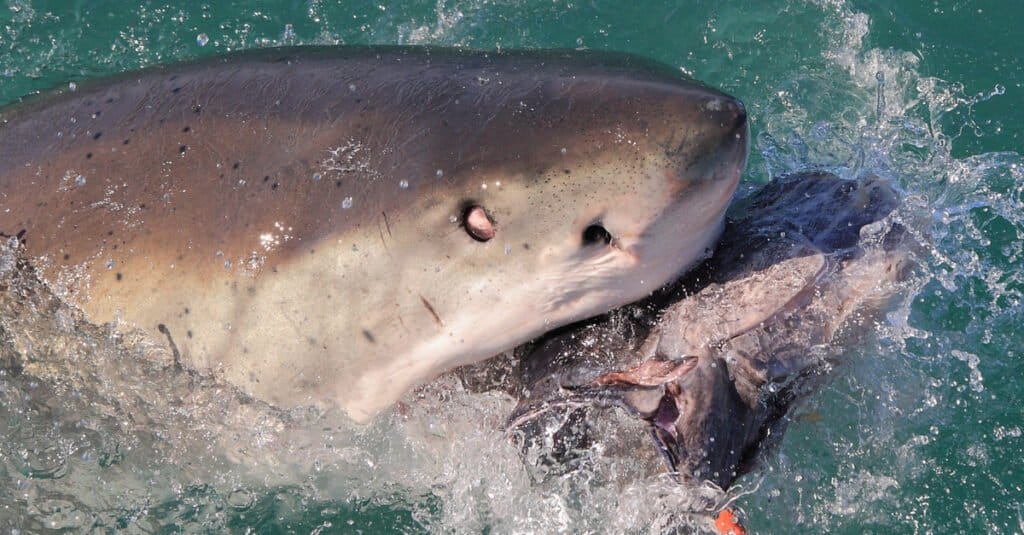
After a particularly big feast, a Great White Shark may not feed properly again for up to 3 months.
©Alessandro De Maddalena/Shutterstock.com
Interesting Facts and Features
Great White Sharks have an exceptional sense of smell which they use to detect prey. Amazingly they are known to be able to sniff out blood in the water from one-third of a mile. Along with other shark species, Great White Sharks have special organs known as lateral lines (rib-like lines on the sides of their body), which can detect the tiny electromagnetic field generated by other animals in the water, which they use to find prey. Hunting larger prey species means that feeding for Great White Sharks can be done more efficiently than if they fed on smaller fish and birds. Great White Sharks are thought to consume an average of 11 tonnes of food every year and, after a particularly big feast, may not feed properly again for up to 3 months. In some situations, Great White Sharks have been known to swim along baring their teeth, which is thought to both serve to warn off competitors for food and rival sharks that may be intruding on their personal space. The Great White Shark is also one of the biggest fish in the world.
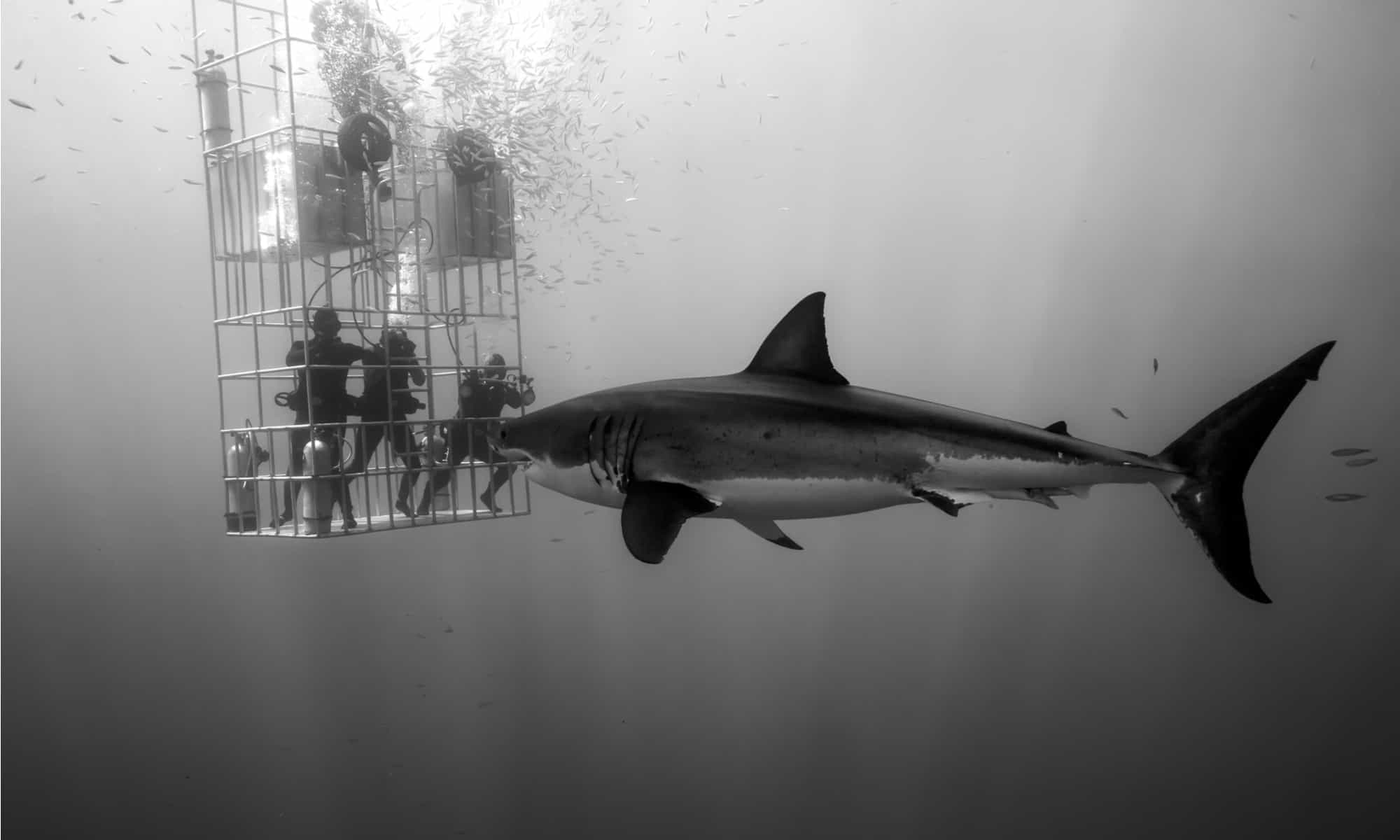
Great white sharks have developed a bad reputation among predatory fish.
©J nel/Shutterstock.com
Relationship with Humans
Humans have a long-established negative relationship with Great White Sharks all around the world, as they are responsible for the majority of all shark attacks on people. Although such attacks are widely documented in the news, fatalities from Great White Shark attacks are thought to be less common than those caused by lightning strikes or bee stings. Due to how Great White Sharks hunt (known as sample biting, where they first attack their prey to wound it before returning to eat), it is widely believed that people are not considered a desirable meal for them. In such instances, returns are incredibly rare. The high-profile nature of these attacks, though, has led to Great White Sharks developing a reputation of being fierce man-hunters when they have mistaken a person swimming or surfing for a seal on the surface of the water. Great White Sharks have also been known to bite or repeatedly bash small boats with their snouts and can cause enough damage to make them sink.
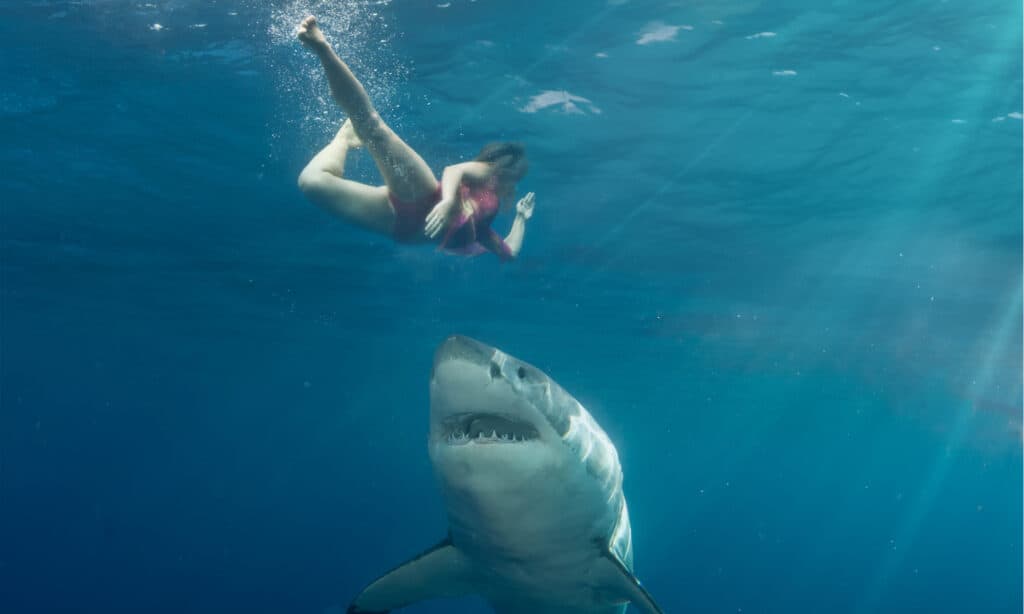
Great White Sharks are the most aggressive sharks worldwide.
©Willyam Bradberry/Shutterstock.com
While attack levels are below many other animals worldwide, Great White Sharks are the most aggressive sharks worldwide, having recorded 333 attacks on humans and 52 fatalities since 1958.
Conservation Status and Life Today
Although little is known about the exact global population numbers of Great White Sharks, particularly in regions where they are less common, their numbers are thought to have declined rapidly over recent years. The IUCN now lists great White Sharks as an animal that is Vulnerable in their native environments, and they are also more heavily protected in certain areas. Hunting, habitat degradation, and campaigns to kill Great White Sharks after a high-profile attack documented in the media have led to their population declines, along with the capture of them to be exhibited in aquariums worldwide.
More on Great White Sharks
- How Deep Can Great White Sharks Dive and What’s Their Deep Sea Prey?
- Discover Why No One Has Ever Seen a Great White Shark Give Birth
Great White Shark FAQs (Frequently Asked Questions)
Are Great White Sharks herbivores, carnivores, or omnivores?
Great White Sharks are Carnivores, meaning they eat other animals.
What Kingdom do Great White Sharks belong to?
Great White Sharks belong to the Kingdom Animalia.
What class do Great White Sharks belong to?
Great White Sharks belong to the class Chondrichthyes.
What phylum to Great White Sharks belong to?
Great White Sharks belong to the phylum Chordata.
What family do Great White Sharks belong to?
Great White Sharks belong to the family Lamnidae.
What order do Great White Sharks belong to?
Great White Sharks belong to the order Lamniformes.
What type of covering do Great White Sharks have?
Great White Sharks are covered in Tough skin.
What genus do Great White Sharks belong to?
Great White Sharks belong to the genus Carcharodon.
Where do Great White Sharks live?
Great White Sharks are found worldwide.
In what type of habitat do Great White Sharks live?
Great White Sharks live in temperate, coastal waters and open oceans.
What are some predators of Great White Sharks?
Predators of Great White Sharks include killer whales, sharks, and humans.
What are some distinguishing features of Great White Sharks?
Great White Sharks have large pointed snouts and powerful tail fins.
What is an interesting fact about Great White Sharks?
Great White Sharks can grow to more than 8 meters long!
What is the scientific name for the Great White Shark?
The scientific name for the Great White Shark is Carcharodon carcharias.
What is the lifespan of a Great White Shark?
Great White Sharks can live for 30 to 40 years.
What is a baby Great White Shark called?
A baby Great White Shark is called a pup.
How many species of Great White Shark are there?
There is 1 species of Great White Shark.
What is the biggest threat to the Great White Shark?
The biggest threats to the Great White Shark are hunting and habitat degradation.
What is the optimal pH for a Great White Shark?
The optimal pH for a Great White Shark is between 5.0 and 7.0.
What is another name for the Great White Shark?
The Great White Shark is also called the white shark or white pointer shark.
How many Great White Sharks are left in the world?
The population size of the Great White Shark is unknown.
How fast is a Great White Shark?
A Great White Shark can travel at speeds of up to 15 miles per hour.
Who would win in a fight: Great White Shark vs. Crocodile?
A great white shark would win a fight against a saltwater crocodile.
These deadly creatures are incredibly powerful, but the great white shark has an amazing advantage in the water. Not only would this animal probably notice the crocodile first, but it also has the speed to land a devastating attack.
Who would win a fight: Tiger Shark Vs Great White Shark?
A great white shark would win a fight against a tiger shark.
The great white shark is too large and powerful for the smaller tiger shark to overcome. Even though the tiger shark would have difficulty ambushing the great white, unless it managed to deal a devastating blow to the bigger fish, it would be setting itself up for a bad counterattack.
What are the best movies about sharks?
The best movies to stream featuring sharks include Jaws, Kon-Tiki and Deep Blue Sea, among others!
What is the difference between a Megamouth Shark and a Great White Shark?
The main difference between a megamouth shark and a great white shark is that megamouth sharks are deepwater filter feeders, while great whites are surface-dwelling apex predators.
Check other differences here.
What are the differences between the great hammerhead and the great white shark?
The major differences between the great hammerhead shark and the great white shark are seen in their size and appearance.
What are the differences between the ridgeback shark and the great white shark?
The major differences between ridgeback sharks and great white sharks lie in their size, appearance, and diet.
What are the differences between great whites and salmon sharks?
While great white sharks and salmon sharks are closely related, the primary difference between the two is that great white sharks are significantly larger than salmon sharks.
Thank you for reading! Have some feedback for us? Contact the AZ Animals editorial team.
Sources
- David Burnie, Dorling Kindersley (2011) Animal, The Definitive Visual Guide To The World's Wildlife / Accessed November 28, 2008
- Tom Jackson, Lorenz Books (2007) The World Encyclopedia Of Animals / Accessed November 28, 2008
- David Burnie, Kingfisher (2011) The Kingfisher Animal Encyclopedia / Accessed November 28, 2008
- Richard Mackay, University of California Press (2009) The Atlas Of Endangered Species / Accessed November 28, 2008
- David Burnie, Dorling Kindersley (2008) Illustrated Encyclopedia Of Animals / Accessed November 28, 2008
- Dorling Kindersley (2006) Dorling Kindersley Encyclopedia Of Animals / Accessed November 28, 2008
- National Geographic / Published November 15, 2017 / Accessed November 15, 2017
- IUCN Red List / Published September 2, 2020 / Accessed November 15, 2017


















